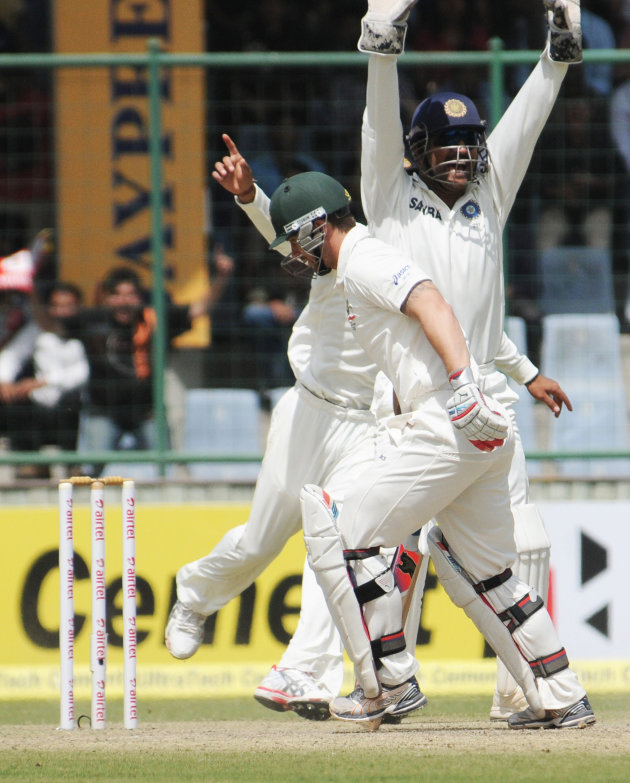The Australians showed lack of skill and character and were whitewashed by India in the recent Test series, but at least in one aspect they were true to form: there was no excuse-making after the 0-4 drubbing.
I half expected a spate of criticism against the pitches that Michael Clarke and his team had to confront, followed by a tirade against the Indian Premier League — in which several Aussies are participants — as the reasons for the country’s misfortunes on the tour.
Thankfully, there was very little of this. The Australian team swallowed its pride without tantrum. Indeed, many fans and followers of the Aussies were surprised that the team played without the abrasiveness of old , citing this as a major shortcoming.
But that is puerile logic: when you are beaten fair and square, best bite the bullet. The many critics back in Australia, too, laid the blame at the team’s door.
This is not just laudable, but also worth emulating because it takes away petty- fogging, focusing instead on the causes of failure.
True, the pitches on which the Tests against Australia were played were prepared to assist spinners from the first ball. However, when teams have come to the sub- continent, they are prepared for turning tracks. This is not a new development, but a truism borne out by the sport’s 80- year- history in India.
Critics of the Indian team and the conditions obtained here often tend to forget that ‘ home advantage’ is sought to be derived by every country, by various means and ruses.
For instance, in recent times, Tests in South Africa have seen visiting teams being bowled out for 50 or thereabouts, but there has been no universal condemnation of the pitches.
If anything, I thought the pitches in the recent series against Australia were quite good. Of course they were turning tracks, but this had worked to India’s disadvantage against England because they played poorly. Australia, despite winning the toss in all four matches, just muffed it up.
That said, the Indian cricket establishment — including players, selectors and administrators — has been prone to passing the blame on to extraneous reasons in times of setback.
The whitewash against England in 2011 was attributed to injuries to key players, that in Australia to the pacy, bouncy pitches Down Under. Apart, of course, from the fact that the side was in transition.
While these explanations were not bereft of truth, they were at best half- truths. Lack of preparedness – physical and psychological - combined with misplaced belief in the waning powers of superstars created so many fault lines that the results in those series could hardly have been any different.
This is where the Indian establishment now needs to learn from the Australians, who are also in the process of rebuilding their team.
They have accepted that a shortage of skill – and dare I say will too — saw them suffer their most humiliating defeat in 44 years. Their concern, if one understands Ian Chappell’s plaint correctly, is to find players who will take Australia back to the top- rank in the world again, not just winning at home.
Indeed, that is the challenge confronting India too now. If they have to possibly regain the No. 1 position they now have to do well overseas because there is no home series for 18 months.
Mind you, the true test of ability — individual and collective — is not only in playing overseas, but faring well in different conditions.
There are those who are loath to give India credit for beating Australia at home. But that is being misanthropic.
After losing to England even at home, this turnaround was remarkable. Some credit for this must also be given to the selectors for some bold decisions.
In dropping Gambhir and Sehwag and sending Zaheer into rehab, Sandeep Patil and Co.
showed they mean business. The selection of youngsters like Jadeja, Dhawan and M Vijay also paid off.
Sachin Tendulkar is, of course, the raging debate once again. I think the time is ripe for the selectors and him to sit down together, assess the situation and demands of the team, reach an understanding on how the future should unfold. There is no reason why this should be shrouded in mystery.
India now has a core of high quality players who should serve the team for a fair while. Finding four or five wicket- taking fast bowlers is their immediate task.
Whether the team will do well overseas is a matter of conjecture, but there is reason to be optimistic.
Meanwhile, another season of the IPL is on us again, accompanied inevitably with a controversy yet again. This storm too will pass though, for the aye- sayers seem to outnumber the naysayers by millions.
Hence i am changing the blog topic to IPL 6, hope it will be interesting.

No comments:
Post a Comment
Your views